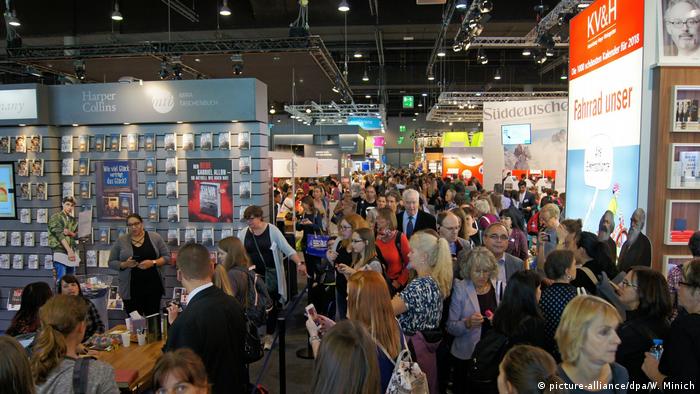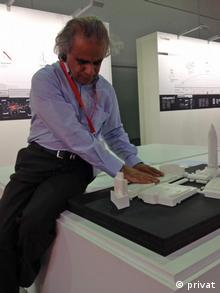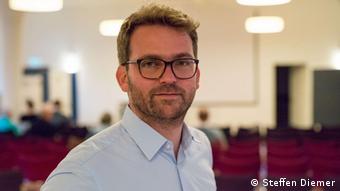Architecture Professor Martin Knöll from the technical University of Darmstadt, Germany is researching on the topic of barrier-free trade fair. At the Frankfurt book fair he explains in a DW Interview, such as the visit can also be Blind to the good experience.

DW: How did you get on the topic of “barrier-free fair”?
Martin Knöll: We city planners want to make our cities better. Cities are under a pressure to Change: they have to adapt to climate change and to changing forms of mobility. Also, the demographic change affects urban areas. From this and the diversity of people who use the cities day-to-day, grown-up demands on the public space. One of them is the accessibility.
Recently, the “day of the white Cane”. With your help, the day that a blind man can walk without the white cane through the huge exhibition halls?
I hope, and I think that is a wonderful picture. We try to do our part. One is the role of the built environment, the architecture, and on the other hand, the digital environment on the one hand. These two environments merge more and more with each other. And it is precisely here that there is Potential for assistance systems, which can contribute to such an implement.

The author on the Stand for a blind project at the Frankfurt book fair
What are you specifically on your Stand?
Our Stand is a test laboratory, in which we imagine small-scale things, which can later facilitate the visit to the fair. For example, a tactile model of the Fairgrounds from the 3D printer, we investigate the question of want: How does it feel and where it must be to help blind people with orientation.?
Second, we present analysis results from the previous year. In 2017, we have attempted to document the barriers as well as possible. To this end, we have done walks with about 20 people and by using their information cards, created to give the information about where the barriers are and how they look.
Some of these barriers, we have selected and tried to eliminate it with simple means. An example is the hall 3, the busiest of all the exhibition halls is here. Here the visitors are concentrated at the entrances. So, we thought: How can we equalize these flows and direct? Our answer was a red carpet that leads visitors through the side entrances, which are also used.
In addition, we have broadened a speed of three meters to five meters. Just mobility-impaired visitors had told us that you come here, barely along not to rotate, and consequently, the stands are not really able to visit. Now you can see how people stay in this gear all of a sudden because you have more space, talking to the stands to watch.

City planner Martin Knöll: Our goal is the completely barrier-free Frankfurt book fair is
The Plan, therefore, to make the exhibition fully accessible?
That is the goal, but we are aware that this needs a lot of steps. Fortunately, we have the book fair for a Partner who is aware of, and we architects have been commissioned to explore the theme.
In the year 2017 you have documented barriers, in the year 2018, prototypes tried. What’s coming in 2019?
Since we will not be, unfortunately, arrived still in your Vision, a blind person can Orient without the white stick. But many of the measures that we introduce here, are very well received. We aim to build on in the next year.
The organizers of the fair have offered this year, pick-UPS and guided tours for people with disabilities. This is also due to your Initiative?
In the framework of our project is in many Places been said, that there is the need. Therefore, it is certainly also the merit to have such things. According to what I hear from the person responsible, the service at the Blind very well and is very well used. He must speak but also from time to time.
A blind is also oriented on the basis of noise. You have chosen for your booth hall 3, where many children’s book publishers present. Accordingly, it is loud. In addition, it was here laid carpeted floor. This makes it the Blind difficult to Orient themselves acoustically. Have you thought to go into a quieter hall?
We wanted samples. Hall 3 a hall, the lives. Especially with the children – and youth books, it speaks to an age group that is interesting. We feel very comfortable here. With the volume and the noise is an interesting topic in architecture. Directly in front of us, three types of surfaces: a smooth, a surface of concrete, and in addition, we have a carpet with extraordinary depth. We offer our visitors to sit in a wheelchair and try them out yourself: what are the different Rolling resistance? In this direction it is necessary to investigate further: What can do such different surfaces for the acoustics?
All the senses are an important issue. Architects and designers are familiar with the Two-sense principle: If the user is the built environment fails in a sense, then buildings and structures must appeal to at least a second sense, or to treat. And because of the acoustics comes into play.
Martin Knöll is a Professor of urban planning and Design in the Department of architecture at the TU Darmstadt. He directs the research group on “Urban Health Games”.